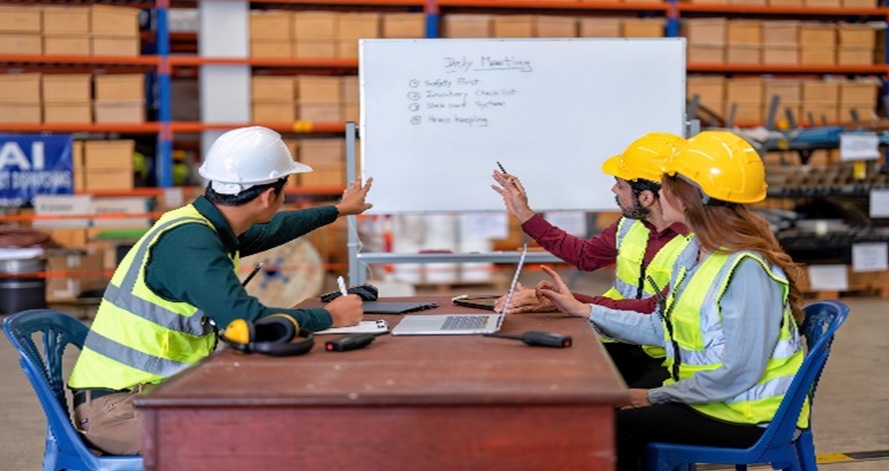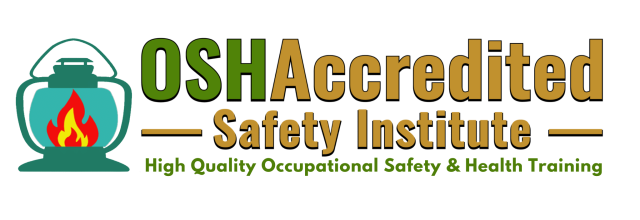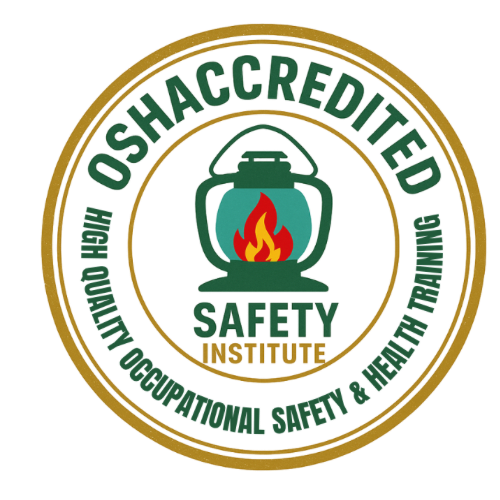The Role of Safety and Health Training in Effective Safety Committees
The Role of Safety and Health Training in Effective Safety Committees
Safety committees play a vital role in ensuring the well-being of employees in the workplace. Their primary objective is to create and maintain a safe working environment by addressing potential hazards, promoting safety and health training, and ensuring compliance with safety regulations, such as those established by the Occupational Safety and Health Administration (OSHA). A well-organized and effective safety committee meeting can make all the difference in preventing accidents, improving safety awareness, and enhancing the overall health and safety culture of the organization.
This blog will delve into the importance of safety training, online safety training, safety courses, OSHA training, and OSHA courses, while exploring best practices for running effective safety committee meetings. We’ll cover OSHA requirements, committee purposes, roles and responsibilities, preparation, communication, conflict resolution, decision-making, and post-meeting responsibilities.
Definition of a Safety Committee
A Safety Committee is a group of employees, typically consisting of both management and staff representatives, that is responsible for overseeing and promoting workplace safety. The committee’s primary functions include identifying potential hazards, evaluating safety risks, ensuring compliance with safety regulations (such as those set by OSHA), and recommending or implementing safety measures to protect workers. They also play a key role in organizing safety training, investigating incidents, and fostering a culture of safety within the organization. The committee meets regularly to discuss safety concerns, review reports, and ensure that safety protocols are followed and continuously improved.

Why Safety Committees are Important?
A Safety Committee is essential because it helps create a structured approach to identifying and addressing workplace hazards, ensuring the safety and well-being of employees. By actively monitoring risks, promoting safety protocols, and adhering to regulatory standards, the committee plays a critical role in preventing accidents and fostering a culture of safety. Safety and health training benefit committee members by equipping them with the knowledge and skills needed to assess and manage risks effectively, understand compliance requirements, and identify emerging safety concerns. This safety training not only enhances their ability to make informed decisions but also empowers them to lead by example, ensuring that safety practices are integrated into everyday operations and that employees are adequately educated on potential hazards.
OSHA Requirements for Safety Committees
Before diving into the structure and function of safety committee meetings, it’s important to understand the regulatory framework under which they operate. OSHA (Occupational Safety and Health Administration) sets forth guidelines and standards that ensure workplace safety across various industries.
OSHA requires businesses to establish safety committees under specific conditions, such as for certain types of high-risk industries or workplaces with a-large number of employees. While OSHA does not mandate that every organization create a safety committee, it does require employers to provide a safe and healthful working environment. This responsibility often necessitates the formation of a committee, especially in complex or high-risk environments.
Safety training and safety training programs are essential to meeting OSHA‘s standards. These programs ensure employees understand the hazards associated with their work, the procedures for reporting safety issues, and their roles in maintaining safety within the organization. Online safety training and specialized OSHA courses are highly beneficial because they can be completed flexibly and efficiently, ensuring compliance across diverse workforces.
Safety Committee Purpose, Role, and Responsibilities
The core purpose of a safety committee is to identify workplace hazards, recommend corrective actions, ensure the effectiveness of safety measures, and promote a safety-conscious culture within the organization. The committee’s role includes assessing potential risks, developing safety protocols, and ensuring that all employees are adequately trained to deal with these hazards.
Key responsibilities of a safety committee include:
- Reviewing Incident Reports: Safety committees should review accident and injury reports to identify recurring hazards and determine whether safety protocols need improvement.
- Conducting Safety Inspections: Committee members should routinely inspect the workplace to identify potential risks or unsafe behaviors.
- Developing and Overseeing Safety Training Programs: Safety committees ensure that workers receive effective safety training and are aware of workplace risks, emergency procedures, and safe work practices.
- Monitoring Compliance with OSHA Regulations: Safety committees ensure that the company complies with OSHA standards and regulations. This includes ensuring that all employees complete required OSHA training courses.
With the rise of remote work and the shift toward flexible learning options, online safety and health training has become an essential tool. These programs are accessible, affordable, and can be customized to meet specific industry needs. They also allow for OSHA-compliant online safety courses, ensuring employees receive health and safety training that is both relevant and legally sound.

Meeting Preparation
To ensure an effective safety committee meeting, proper preparation is key. Preparation should start well before the meeting date. The safety committee should:
- Set clear objectives for the meeting: Outline the key topics, such as safety inspection results, training needs, and incident reports.
- Review prior meeting notes: Look over the minutes from previous meetings to ensure that action items were completed and that any ongoing safety issues have been addressed.
- Collect relevant materials: Gather reports, safety training schedules, and any other documentation related to workplace safety, such as OSHA logs, safety audit results, and health and safety training completion records.
Safety courses, both in-person and online, can also be reviewed during meetings, particularly if there is a need to update or expand the organization’s safety training programs. The safety committee should be proactive in identifying new safety training courses that can address emerging safety concerns or compliance updates.
Agenda
A well-structured agenda is the backbone of any productive meeting. A typical safety committee agenda should cover the following items:
- Opening Remarks and Welcome: Briefly outline the meeting’s purpose and desired outcomes.
- Review of Previous Minutes: Discuss action items from the last meeting and any ongoing concerns.
- Incident Reports and Safety Updates: Present accident or near-miss reports, safety inspection results, and recommendations.
- Training and Development Updates: Discuss upcoming safety training sessions, including online safety training or OSHA-specific courses.
- Safety Program Improvements: Discuss any necessary updates to existing safety protocols or the development of new initiatives.
- Open Forum: Allow committee members to raise any safety concerns, ask questions, or offer suggestions.
Ensuring that online safety and health training and OSHA courses are part of the discussion will keep the team focused on ensuring continuous education and OSHA compliance with legal requirements. As organizations strive to improve safety measures, committee meetings should emphasize the importance of ongoing safety training.
Conducting the Meeting
A well-conducted meeting requires focused discussions, clear communication, and efficient management of time. The chairperson of the safety committee should take responsibility for facilitating the meeting, ensuring all topics are covered, and that all members have an opportunity to contribute. A successful meeting requires an atmosphere where all voices are heard and respected.
Safety committee communication should be transparent and encourage collaboration. For example, when discussing safety training needs, committee members should share any challenges employees face in completing safety courses or OSHA training, such as scheduling conflicts or accessibility issues. This dialogue will help the committee adjust health and safety training delivery methods, ensuring that safety training is accessible and effective.
Safety Committees and Meetings
https://osha.oregon.gov/pages/topics/safety-committees-and-meetings.aspx
Safety Committee Communication and Problem-Solving Techniques
Effective communication and problem-solving are vital in safety committee meetings. In the context of workplace safety, communication should be clear, concise, and direct, ensuring that all safety concerns are addressed and understood. Regular updates on safety and health training and progress on action items should be shared openly.
Problem-solving techniques in safety committee meetings should focus on root cause analysis, identifying both immediate and long-term solutions for preventing workplace hazards. For example, when analyzing a recent injury, committee members should consider factors such as:
- Training gaps: Was there a lack of safety education? Should additional online safety training or OSHA courses be offered?
- Safety equipment: Was appropriate safety equipment available, and was it used correctly?
- Workplace environment: Were there physical hazards that contributed to the incident?
The goal of the safety committee should be to foster a culture of continuous improvement, where safety protocols evolve based on input from the entire team and insights gained through OSHA-compliant courses.
Decision-Making
Decision-making in safety committee meetings should be based on data, research, and evidence. Whether the committee is deciding on new OSHA training schedules, updating safety protocols, or choosing which safety issues to address first, decisions should be made with careful consideration of the available information.
When discussing whether additional health and safety training is necessary, the committee might look at accident trends, employee feedback, and the results of safety audits. If online safety and health training is proposed, the committee should consider its cost, convenience, and whether it meets OSHA’s standards.

Handling Disagreement and Conflict
As with any group setting, disagreements may arise. In a safety committee meeting, this could happen when committee members have differing views on the severity of a safety issue, the effectiveness of a safety training programs, or the best course of action to address a problem.
Handling conflict respectfully and constructively is essential to maintaining a productive environment. Encourage open dialogue, acknowledge differing opinions, and focus on finding a compromise or consensus that benefits the entire organization. It’s important to remember that the goal is to improve workplace safety, not to “win” a debate.
Post-Meeting Responsibilities
Once the meeting concludes, the work doesn’t stop. The safety committee must ensure that all action items are tracked and completed. This includes:
- Distributing Meeting Minutes: Send out the meeting notes promptly, highlighting decisions made, action items, and deadlines.
- Follow-Up on Action Items: Ensure that safety concerns are addressed, and that safety training or OSHA courses are scheduled or updated as needed.
- Monitor Progress: Track the success of any new safety initiatives or safety training programs and assess their impact on reducing workplace hazards or improving compliance.
Occupational Safety and Health Committees
https://www.osha.gov/laws-regs/regulations/standardnumber/1960/1960.40
Conclusion
Safety committee meetings are an essential part of maintaining a safe and compliant workplace. They provide a forum for addressing safety concerns, developing safety training programs, and ensuring that both employees and employers remain committed to safety practices. The integration of safety training, online safety courses, and OSHA training ensures that the workforce is well-prepared to identify and mitigate risks.
By following best practices for meeting preparation, conducting efficient and effective meetings, and addressing any conflicts or disagreements in a professional manner, safety committees can achieve their goals of creating a safer working environment. Through collaboration, communication, and a commitment to ongoing safety education, businesses can significantly reduce the likelihood of accidents, improve overall safety, and comply with all regulatory requirements, ultimately fostering a culture of safety in the workplace.
In conclusion, an organized, proactive safety committee is key to ensuring that safety is prioritized, and that safety training and OSHA regulations are adhered to, providing lasting benefits for employees and the organization as-a whole.
Author: Dr. O’Neil G. Blake, Chief Executive Officer (CEO) of OSHAccredited Safety Institute
MS., MBA., MSc., BSc, CSP., ASP., CSHM., CSMP., MRSA.
Date: 12-30-2024












Comment (1)
admin
Thanks for your comments